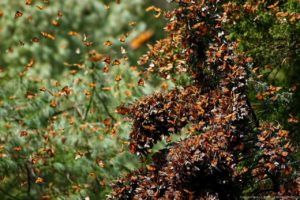13
Feb
Herbicide Use Contributes to Declines in Monarch Populations
(Beyond Pesticides, February 13, 2017) A study by the World Wildlife Fund (WWF) and others attributes the reduced number of overwintering monarch butterflies –a reduction of 27% from last year—to herbicide use and other factors. The World Wildlife Fund (WWF), in conjunction with U.S. and Mexican environmental groups, has been leading the effort in tracking monarch butterflies. Their recently released 2016-2017 study concluded that the population of monarch butterflies decreased 27 percent from last year’s population, which had marked an increase from dangerously low levels over the previous three years. Overall, this marks an 80 percent decline in monarch population from the 1990’s. Researchers have estimated that within 20 years the monarch butterfly migration could collapse altogether.
The study was conducted in December of 2016 when the colonies of monarchs are expected to be at their peak population in Mexico. Monarch populations are gauged by the area of land they inhabit, rather than counts of butterflies. Thirteen butterfly colonies were observed, recorded and tracked using geographic information systems software. The researchers found that the butterflies occupied 2.91 hectares of forest, which re
 presents a 27.43 percent decrease in population compared to the 4.01 hectares of forest they inhabited during the 2015-2016 migration season.
presents a 27.43 percent decrease in population compared to the 4.01 hectares of forest they inhabited during the 2015-2016 migration season.
A combination of factors have led to the declining populations of monarch butterflies. A series of extreme weather events in Mexico last fall are partly to blame for this seasons decline. Unusually cold and wet weather last March of 2016 limited the success of the butterflies return migration back to the United States and Canada. Habitat loss and illegal logging operations in Mexico’s Oyamel forest are also being looked at as a possible driver for monarch population decline.
Monarch butterflies lay their eggs on milkweed that grows wild, and reduced sources of milkweed pose a threat to monarch populations. The use of genetically engineered crops allows the use of glyphosate in cropland, which is an important factor in the decline of the monarch.
In a press release from the Mexico’s WWF branch, Omar Vidal stated, “The monarch migration is a phenomenon like no other. But now, it’s imperiled by forces the monarchs themselves cannot control. The reduction in the area of forest they occupied this year –most probably due to the high mortality caused by storms and cold weather last year— is a clear reminder for the three countries that they must step up actions to protect breeding, feeding and migratory habitat.” Mr. Vidal continued, “We cannot control the climate, but we can do much better in eradicating illegal logging in the reserve and tackling habitat loss in the U.S. and Canada. But, even if Mexico’s overwintering sites never lose another tree, without food and habitat along the migration routes the forests will soon bid farewell to their final orange and black-winged tenant.”
Monarch butterflies are one of many important pollinator species that have experienced drastic declines in recent years. Along with threats from glyphosate use and habitat loss, the use of neonoicotinoid pesticides has also been linked to monarch declines. In addition to monarch butterflies, honey bees and wild bees have also been experiencing a drastic decline in numbers that has been linked to the prevalent use of neonicotinoids. A recent report issued by the European Food Safety Authority (EFSA) states that certain neonicotinoid insecticides pose an unacceptable hazard to honey bees. The EFSA report concludes that systemic contamination of neonicotinoid-treated crops, neonicotinoid dust exposure, and contaminated nectar and pollen contributes to declines in honey bees and weakens their hives. With one in three bites of food reliant on bees and other insects for pollination, the decline of honey bees and other pollinators due to pesticides and other man-made causes demands immediate action. Beyond Pesticides has petitioned the U.S. Environmental Protection Agency (EPA) to suspend the use of bee toxic chemicals pending a full review of their effects on pollinators.
Critical to the survival of monarchs, other pollinators, and organisms essential to ecological balance is the large-scale adoption of organic farming practices. Beyond Pesticides supports organic agriculture as effecting good land stewardship and a reduction in hazardous chemical exposures for workers on the farm. The pesticide reform movement, citing pesticide problems associated with chemical agriculture, from groundwater contamination and runoff to drift, views organic as the solution to a serious public health and environmental threat.
On a personal level, several steps may be taken to attract beneficial insects like monarchs and protect backyard habitats. Like any other living organisms, pollinators need food, water, and shelter in order to thrive. For more information, see Managing Landscapes with Pollinators in Mind and Hedgerows for Biodiversity: Habitat is needed to protect pollinators, other beneficial organisms, and healthy ecosystems. More information is available in the BEE Protective Habitat Guide and Do-It-Yourself Biodiversity.
Source: Center for Biological Diversity, World Wildlife Fund
All unattributed positions and opinions in this piece are those of Beyond Pesticides










